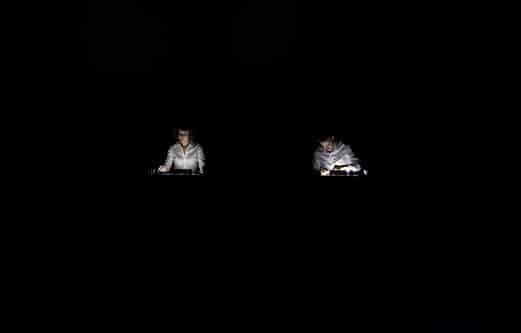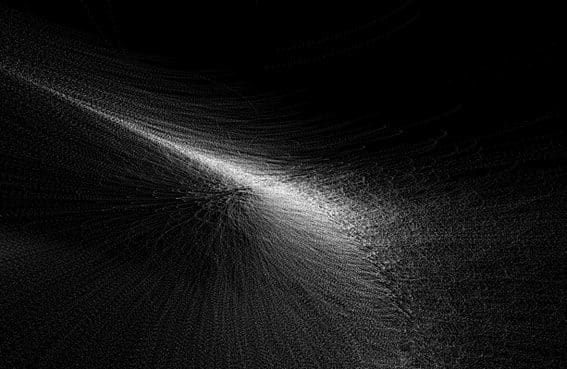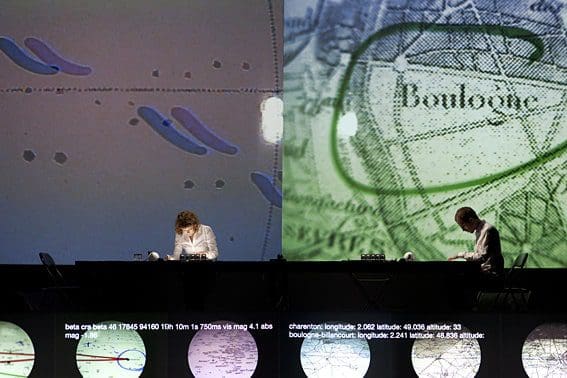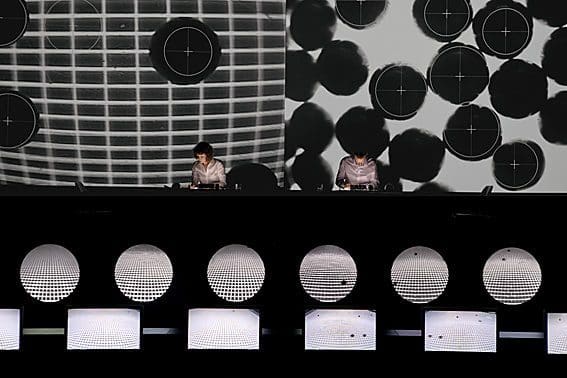It seems that what could be construed as two artistically distinct domains are in fact more closely related and compatible than we can imagine…
Ryoji Ikeda, on the 27th and 28th March, demonstrated the extraordinary unity of science and art in his recent UK premiere of Superposition at the Barbican, through a stunning and thought-provoking collaboration of visuals, sound art and – for the first time in his career – onstage live electronics. The result of such a glorious fusion of art forms by far exceeded the expectations of your typical “performance”; the Superposition experience was more of a sensation: a beautifully crafted attack on the senses – an intellectually weighted thrill ride.
Superposition – the scientific phenomenon itself – plays a significant role in the work, as one would expect, the most immediately obvious being the nature of the visual imagery (credit to Yoshito Onishi for the outstanding visual art in the work) utilised in the performance of the same name. Visual representations of quantum mechanics (of which superposition is a fundamental principle); and, by association, mathematics, equations and formulae, data, atomic structure, numerical sequences, elements of the cosmos, all flashed – often at a disconcertingly rapid speed – in sync with Ikeda’s wonderfully formulated minimalist electronica score, across the numerous screens facing the audience (one large cinema-style screen at the back, a lower, rectangular one fronting a large desk and ten computer monitors lining the front of the stage).
Does this idea of quantum theory run deeper than this immediate, visual performance surface, however? Well, yes, in the sense that Ikeda’s composition is driven by his interest in mathematics, whereby mathematics is the foundation of music; music is, in turn, deeply rooted within the inner workings of our world, and our world lies within a universe that we have attempted to understand on an atomic and sub-atomic level, through the principles of what we have called ‘quantum mechanics’… a profound and complex relationship that becomes more bemusing and more fascinating the further it is considered. But – and this is an important ‘but’ -Ikeda affirms that an understanding of such concepts is not integral to a full appreciation of his work. This, I believe, is of great importance; Superposition is not a work purposefully packed with esoteric allusions designed appeal to the intellectual elite and baffle the majority; Superposition is a piece created to, in Ikeda’s own words, “challenge people’s thinking a bit.” After all, the probability of the audience majority being sufficiently educated in quantum theory and advanced mathematics in order to entirely understand this side of the work would, of course, be zero to none. So, why should such a wonderfully mystifying and compelling concept be accessible only to a select few, when it’s so relevant to us all?
This is not, by any means, to imply that the ‘scientific’ visuals of the work are only there to initiate a thought process/synchronise well with the music and otherwise have little meaning. The visuals all hold relevance to the scientific background of the work, and that’s one of the greatest things about Superposition; if you are intellectually equipped to understand these things, they actually make sense, but even if you don’t (as would be the case for most of us, I imagine) the experience is intended to be equally as enjoyable. As Ikeda says, “The show is an immersive and viscerally exciting music experience, be the viewer a music and art lover or a physicist – or both. Quantum mechanics plays a key role in my approach to composition, but they will be invisible to any spectator who doesn’t understand them and that won’t stop them enjoying the work.”
Concept aside, the music is blinding in its own right. Most of us know Ikeda for his seminal album, +/- (1996), a work that pioneered and inspired a new and radical realm of minimalist electronic composition (which employs the glitch ‘failure’ aesthetic – a reaction to our new digital society) through the use of ‘raw’ music states such as sine waves and white noise. The music in Superposition is not dissimilar to this on a base level, but the sound palette is much more varied, as is the rhythm. The compositional layering too is much more complex, which makes for a much more captivating experience overall (it goes without saying that the powerful speakers used in the auditorium at the Barbican enhanced this beyond measure).
The performance began as it intended to go on; the first sound that pierced the darkness of the eerily silent theatre (a low, rumbling frequency) was uncomfortable, intense, and highly dramatic. Discomfort is, in a way, an inevitable (and absolutely necessary, I would say) by-product of Superposition; anyone who has listened through +/- will understand this. Frequencies that our ears aren’t accustomed to, played for prolonged periods of time – particularly at a high volume – can feel very strange, often painful. Relentless repetition of rhythmic patterns, notes, textures, images…continuous bombardment of unnaturally pure waveforms, rapid alternation of pitch black and bright light, extended periods of live electronics sequences (the performers of which were astounding in their precision and control), unusual combinations of tones resulting in tone clusters that are really quite frightening, all for a straight, seventy-four, uninterrupted minutes. The experience is not something you would encounter anywhere in life and, as a result, it was a treat to observe as much as it was disorientating and brilliantly unsettling. Walking out of the theatre doors and back into the real world was particularly strange: comparable to returning to solid ground after being on a trampoline for a long period of time, except your feet are your ears and the solid ground is the bland soundscape of uninspiring reality.
See www.ryojiikeda.com
words Jess Onacko @Onackoj
photos Daniel Karl Fidelis Fuchs























